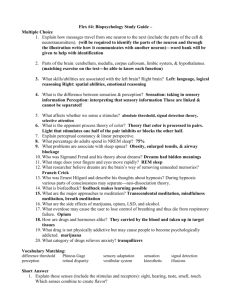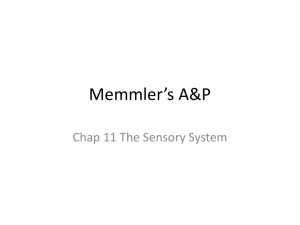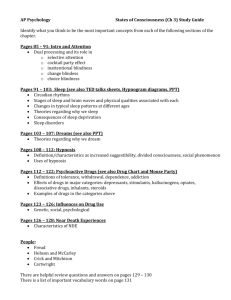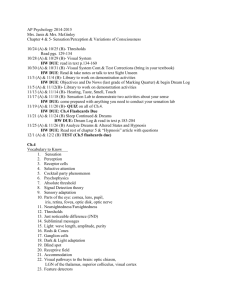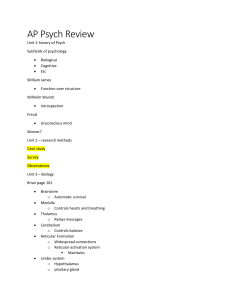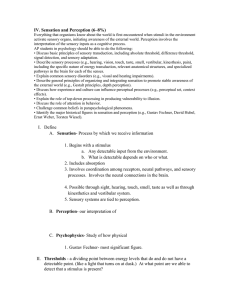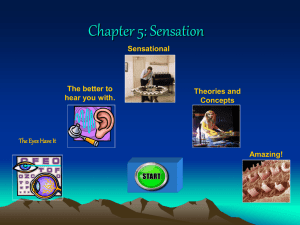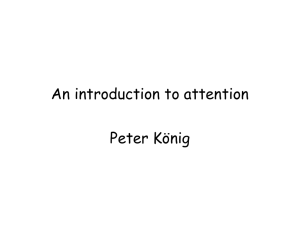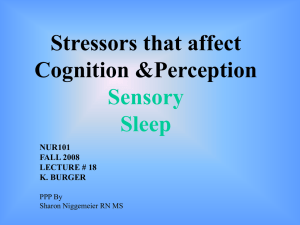Cumulative Test Study Guide – 2015
advertisement
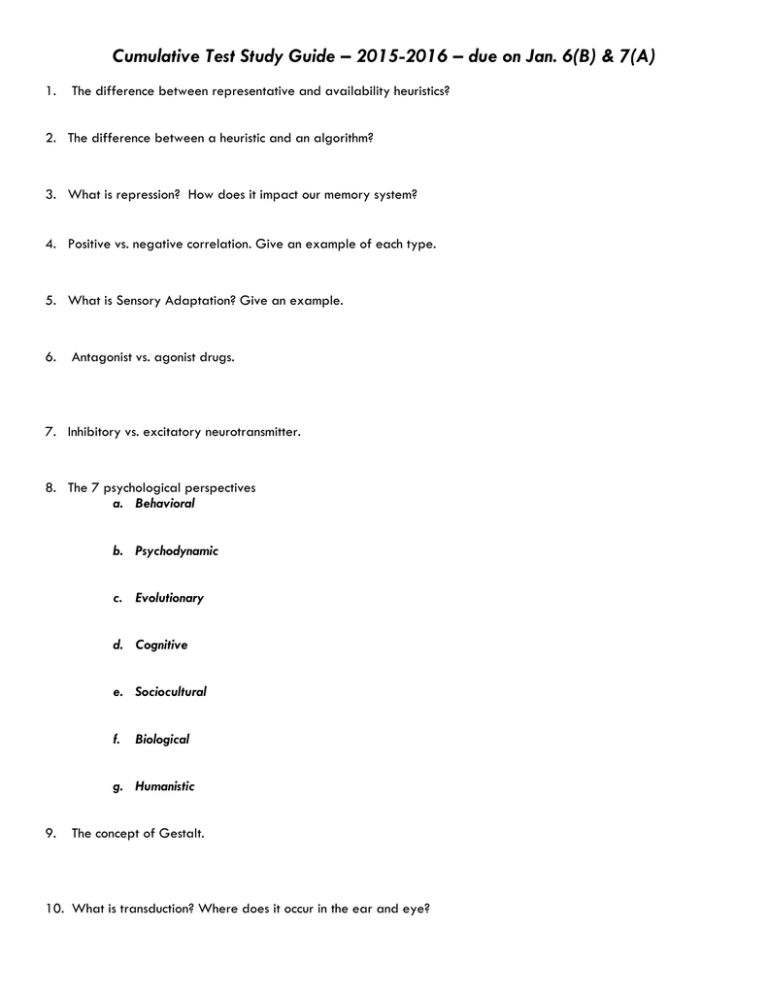
Cumulative Test Study Guide – 2015-2016 – due on Jan. 6(B) & 7(A) 1. The difference between representative and availability heuristics? 2. The difference between a heuristic and an algorithm? 3. What is repression? How does it impact our memory system? 4. Positive vs. negative correlation. Give an example of each type. 5. What is Sensory Adaptation? Give an example. 6. Antagonist vs. agonist drugs. 7. Inhibitory vs. excitatory neurotransmitter. 8. The 7 psychological perspectives a. Behavioral b. Psychodynamic c. Evolutionary d. Cognitive e. Sociocultural f. Biological g. Humanistic 9. The concept of Gestalt. 10. What is transduction? Where does it occur in the ear and eye? 11. Opponent process theory vs. Trichromatic theory. 12. Sensory memory vs. short term memory vs. long term memory 13. How to get memories from sensory to short term. 14. Binocular vs. monocular cues for depth perception. Give examples of each type. 15. Rods vs. cones. 16. What is the serial position effect? How does it impact the recalling of information? 17. Neurotransmitters a. Acetylcholine b. Dopamine c. GABA d. Norepinephrine e. Serotonin f. Endorphins g. Glutamate 18. What is the Gate Control Theory? How does it influence our level of pain? 19. Longitudinal vs. cross sectional research 20. Different imaging technology a. EEGb. CATc. PETd. MRIe. Functional MRI21. Hilgard’s Hidden Observer experiment and the role of dissociation. 22. Withdrawal vs. Tolerance. 23. The all or nothing response and the firing of a neuron. 24. The Visual Cliff Experiment and depth perception. 25. The only research design that can infer causation? 26. How hypnosis can help alleviate pain. 27. Normal Distribution vs. Skewed Distribution. 28. Where the 3 measures of Central Tendency fall on a normal distribution. 29. How extreme scores skew the 3 measures of central tendency. 30. The role of myelin sheath in sending a message. 31. The role of accommodation in vision. 32. Why do we have a blind spot? 33. Benjamin Whorf’s idea of Linguistic Relativity. 34. How encoding, storage and retrieval aid in the process of memory. 35. The 4 Gustatory receptors. 36. What is Syntax? 37. What are semantics? 38. What is hypnosis? 39. The benefits of double-blind research and the reduction of bias. 40. Left vs. Right Hemispheres. 41. Noam Chomsky’s view on language and the Language Acquisition Device. 42. How do operational definitions aid in the process of replication? 43. Parasympathetic vs. sympathetic nervous system. 44. Phi Phenomenon. 45. Wolfgang Kohler Chimpanzee study. 46. Sensory Adaptation 47. Selective Attention. 48. Split Brain Surgery. What is it? Why is it done? 49. Circadian Rhythm. 50. The Vestibular Sense. 51. The role of neurons in the nervous system. 52. Retrograde vs. Antrograde amnesia. 53. Standard deviation, including the standard deviation percentages. 54. Heuristic vs. Algorithm. 55. The process of hearing, using the various parts of the ear. Know which parts are inner, middle and outer ear. 56. The process of seeing, using the various eye parts. 57. What occurs during the 4 stages of sleep and REM sleep. 58. Various glands: pancreas, Thyroid, Adrenal, Pituitary, Pineal. 59. Just Noticeable Difference 60. Weber’s Law. 61. The role of neurotransmitters and the synapse in the process of sending a message. 62. Long Term Potentiation and memory. 63. How does Functional Fixedness inhibit problem solving. 64. Correlation Coefficient. Know what the number means. 65. +.24…………………….. what does this tell you about a correlation relationship 66. What is the function of the following brain structures? a. medulla- b. frontal lobec. cerebral cortexd. amygdalee. ponsf. cerebellum- g. hippocampush. hypothalamusi. temporal lobe- j. occipital lobe- k. parietal lobel. sensory cortex- m. motor cortexn. thalamuso. brain stemp. reticular formationq. Wernicke’sr. Broca’s- 67. Describe the following types of research studies. a. correlation- b. experimentc. surveyd. case studye. naturalist observation68. Describe the following drugs/drug categories. a. cocaineb. marijuanac. heroined. alcohole. nicotinef. LSD- g. An opiateh. An amphetaminei. A depressant- j. A hallucinogen- k. A stimulant- 69. Describe the following parts of a research study a. sample- b. Random Sample - c. Population- d. hypothesis- e. theory- f. control group- g. experimental group- h. independent variable- i. dependent variable- j. operational definitions 70. Describe the following sleep problems A. Sleep Apnea B. Narcolepsy C. Insomnia D. Night terrors E. The REM rebound effect 71. How do the following terms relate to language A. MorphemeB. PhonemeC. Grammer- D. SyntaxE. SemanticsF. Language acquisition device (LAD)- 72. Put the following neurons in the correct order in terms of how vision is processed. Optic nerve, ganglion cells, bipolar cells, rods and cones 73. Draw and label a neuron. Include the following parts Myelin Sheath, Dendrites, Axon Terminals 74. Place theory vs. frequency theory. 75. The role suggestibility plays in the hypnosis. 76. How do avoid sampling bias. 77. Ethical guidelines of research studies. 78. Where transduction occurs in both the eye and ear. 79. Autonomic vs. Peripheral vs. somatic vs. central nervous systems
